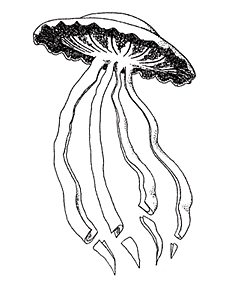Stygiomedusa gigantea
| Stygiomedusa gigantea | ||||||||||||
|---|---|---|---|---|---|---|---|---|---|---|---|---|

Schematic drawing of Stygiomedusa gigantea |
||||||||||||
| Systematics | ||||||||||||
|
||||||||||||
| Scientific name of the genus | ||||||||||||
| Stygiomedusa | ||||||||||||
| Russell , 1959 | ||||||||||||
| Scientific name of the species | ||||||||||||
| Stygiomedusa gigantea | ||||||||||||
| ( Browne , 1910) |
Stygiomedusa gigantea , Syn . : Stygiomedusa fabulosa and Stygiomedusa stauchi , is a very large species of umbrella jellyfish (Scyphozoa)that lives in the deep sea. It is currently the only species in the Stygiomedusa genus .
features
The umbrella of the medusa measures up to about 140 cm in diameter. The color varies from purple to deep brown red. The surface is smooth. It has four mouth tentacles that can be up to 6 m long. The stomach measures about half the diameter of the umbrella; 17 to 18 radial channels emanate from it. There is also a ring channel. In the stomach there are numerous cirri, approx. 5 mm long, which are provided with nettle cells . The animals weigh up to over 90 kg. An exumbrellar groove around the central part of the screen roughly marks the stomach. They have 20 marginal sense organs ( rhopalia ) and about 60 marginal lobes. The mouth is cross-shaped and drawn out into a short mouthpipe.
The interradial gonadal pores have a diameter of 1.5 cm. The species is viviparous ( viviparous ). In the case of the holotype , it was observed that several whitish, ovoid bodies sit on the wall of the gonad on each of the four gonads. They varied in size from 1 × 0.5 cm to 5 × 2.5 cm. A slightly larger body, 7.5 × 5 cm, contained a developing, small medusa. Fully developed small medusas shortly before detachment had an umbrella diameter of 10 cm. None of the young or developing medusa had marginal tentacles. The arms of the mouth are well developed, relatively broad and filamentous.
Geographical occurrence and habitat
According to the sightings and catches so far , Stygiomedusa gigantea is likely to be widespread. So far they have been found in the North and South Atlantic , but also off the American Pacific coast . According to previous knowledge, their habitat is likely to be at a depth of 1000 to 1800 meters.
Way of life
Little is known about the way of life of Stygiomedusa gigantea . Judging by stomach content feeds stygiomedusa gigantea of crustaceans (Crustacea), the type Eryoneicus faxoni Bouvier, 1905 (Family polychelidae ) was found a captive specimen in the stomach contents.
Stygiomedusa gigantea probably lives in symbiosis with the fish species Thalassobathia pelagica ( intestinal fish-like , Ophidiiformes). The fish live around the umbrella of Stygiomedusa gigantea . The fish species get an effective protection against predators. The medusa benefits from removing parasites and catching fish that pursue their symbiote.
Systematics
The genus Stygiomedusa was established in 1959 by Frederick Stratten Russell . The type species at that time was Stygiomedusa fabulosa Russell, 1959. According to more recent studies, Stygiomedusa fabulosa Russell 1959 and also Stygiomedusa stauchi Repelin, 1967 more recent synonyms of Stygiomedusa gigantea (Browne, 1910).
swell
Individual evidence
- ↑ a b Jeffrey C. Drazen and Bruce H. Robison: Direct observations of the association between a deepsea fish and a giant scyphomedusa. Marine and Freshwater Behavior and Physiology, 37: 3, 209-214, 2004 doi : 10.1080 / 10236240400006190
- ↑ RJ Larson and GR Harbison: Medusae from McMurdo Sound, Ross Sea including the descriptions of two new species, Leuckartiara brownei and Benthocodon hyalinus. Polar Biology, 11: 19-25, 1990 doi : 10.1007 / BF00236517
- ↑ Isabella Gordon: Note On the Decapod Crustacean Form Stygiomedusa Fabulosa Russell. Crustaceana, 1 (2): 169-172, 1960 online at jstor.org
- ^ EJ Denton and AJ Southward: Frederick Stratten Russell. Nov. 3, 1897-5 June 1984. Biographical Memoirs of Fellows of the Royal Society, 32: 463-493 1986 Online at jstor.org
- ↑ Robert Repelin: Stygiomedusa stauchi n. Sp. scyphoméduse géante des profondeurs. Cahiers ORSTOM, Series océanographie 5 (1): 23-28, 1967
- ^ GR Harbison, KL Smith, and RH Backus: Stygiomedusa fabulosa from the North Atlantic: its Taxonomy, with a note on its Natural History. Journal of the Marine Biological Association of the United Kingdom, 53: 615-617, Cambridge 1973 doi : 10.1017 / S0025315400058811
- ^ Zooplankton of the South Atlantic Ocean - Stygiomedusa gigantea
literature
- Frederick S. Russell: A Viviparous Deep-Sea Jellyfish. Nature, 4698: 1527-1528, London 1959
On-line
annotation
- ↑ The length of 6 m for the mouth tentacles, as it is stated in some popular scientific representations of the species, could not be fully confirmed in the scientific publications. However, Drazen & Robison determined a tentacle length of 3 to 4 m for a specimen with an umbrella diameter of about 80 cm, so that a tentacle length of 6 m could apply for very large specimens.